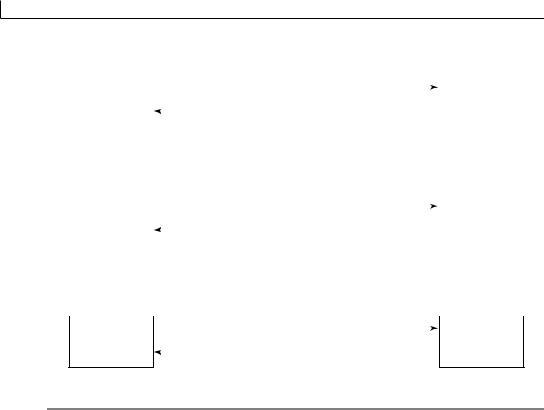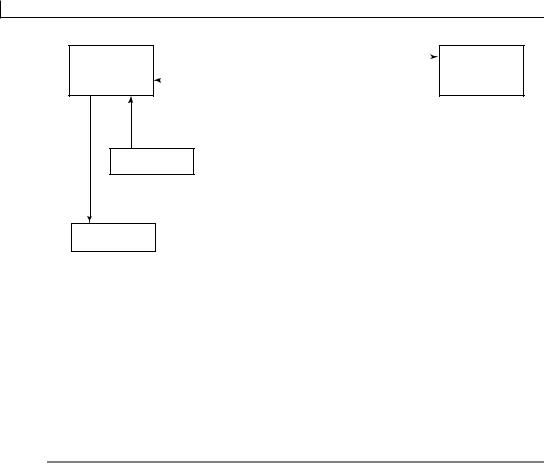
Global corporate finance - Kim
.pdf
182 FINANCIAL SWAPS
Table 7.1 The value of outstanding swaps (billions of US dollars)
Year |
Interest rate swaps |
Currency swaps |
Total swaps |
|
|
|
|
1987 |
683 |
183 |
866 |
1988 |
1,010 |
317 |
1,327 |
1989 |
1,539 |
435 |
1,974 |
1990 |
2,311 |
578 |
2,889 |
1991 |
3,065 |
807 |
3,872 |
1992 |
3,851 |
860 |
4,711 |
1993 |
6,178 |
900 |
7,078 |
1994 |
8,816 |
915 |
9,731 |
1995 |
12,811 |
1,197 |
14,008 |
1996 |
19,170 |
1,600 |
20,770 |
1997 |
22,291 |
1,823 |
24,114 |
1998 |
36,262 |
2,253 |
38,515 |
1999 |
38,372 |
2,444 |
40,816 |
2000 |
47,995 |
2,605 |
50,600 |
2001 |
57,220 |
4,302 |
61,522 |
2002 |
68,274 |
4,560 |
72,834 |
|
|
|
|
Source: The International Monetary Fund, International Financial
Markets, various issues.
7.1.3The growth of the swap market
Salomon Brothers arranged the first currency swap in August 1981, with the World Bank and IBM as counterparties. The World Bank wanted to obtain Swiss francs and German marks to finance its operations in Switzerland and West Germany without having to tap the capital markets of these two countries directly. On the other hand, IBM, which had previously acquired fixed-rate obligations in francs and marks, obtained an unrealized capital gain in terms of dollars when the dollar appreciated. Because IBM’s management believed that the dollar’s appreciation would not continue, it wanted to realize the capital gain and remove itself from its mark–franc exposure.
It was a short step from currency swaps to interest rate swaps. If swaps could be used to convert one type of currency obligation to another at the applicable interest rate on each currency, a similar type of contract could be used to convert one type of borrowing (fixed rate) to another (floating rate). The first interest rate swap was put together in London in 1981, and their use spread to the USA the next year. The swap concept was extended in 1986 when the Chase Manhattan Bank introduced the commodity swap. In 1989, Bankers Trust introduced the first reported equity swap.
Equity swaps are the newest type of swap and are a subset of a new class of instruments known as synthetic equity. Equity swaps generally function as an asset swap that converts the interest flows on a bond portfolio into cash flows linked to a stock index. The stock indexes that have been used include the Standard & Poor’s (S&P) 500, the Tokyo Stock Price Index and Nikkei 225 (Japan), The Chambre des Agents de Change 240 (France), the Financial Times Stock Exchange 100 (United Kingdom), and the Toronto Stock Exchange 300 (Canada).
Table 7.1 shows the amount of outstanding swaps at year-end from 1987 to 2002. By the end of 2002, the total swap market had reached approximately $73 trillion, with about 93 percent

PLAIN VANILLA SWAPS |
183 |
|
|
of the swaps being interest rate swaps and the remaining 7 percent being currency swaps. US dollars account for about 30 percent of these swaps, while the Japanese yen, the euro, the British pound, and the Swiss franc account for most of the remaining 70 percent. The value of outstanding swaps increased over 84 times between 1987 and 2002.
7.2 Plain Vanilla Swaps
The basic form of a swap – the simplest kind – is called a plain vanilla swap. Although many variants of the plain vanilla swap exist, all swaps have the same basic structure. Two counterparties agree to make payments to each other on the basis of some quantity of underlying assets. These payments include interest payments, commissions, and other service payments. The swap agreement contains a specification of the assets to be exchanged, the rate of interest applicable to each, the timetable by which the payments are to be made, and other provisions. The two parties may or may not exchange the underlying assets, which are called notional principals, in order to distinguish them from physical exchanges in the cash markets. In the sections that follow, we discuss the two forms of a plain vanilla swap: interest rate swaps and currency swaps.
7.2.1Swap banks
It is difficult and time-consuming for two end users to arrange a swap directly. A more efficient structure for them is to obtain a financial intermediary that serves as counterparty to both end users. This counterparty is called a swap bank. A swap bank is a generic term used to describe a financial institution that assists in the completion of a swap. The swap bank profits from the bid–ask spread it imposes on the swap coupon.
The swap bank serves as either a broker or a dealer. A swap broker is a swap bank that acts strictly as an agent without taking any financial position in the swap transaction. In other words, the swap broker matches counterparties but does not assume any risk of the swap. The broker receives a commission for this service. A swap dealer is a swap bank that actually transacts for its own account to help complete the swap. In this capacity, the swap dealer assumes a position in the swap and thus assumes certain risks.
7.2.2Interest rate swaps
An interest rate swap is a swap in which counterparties exchange cash flows of a floating rate for cash flows of a fixed rate, or exchange cash flows of a fixed rate for cash flows of a floating rate. No notional principal changes hands, but it is a reference amount against which the interest is calculated. Maturities range from under 1 year to over 15 years, but most transactions fall within a 2-year to 10-year period. While swaps are inherently international in nature, interest rate swaps can be purely domestic. However, when they are arranged in the Eurocurrency market, interest rate swaps have counterparties from different countries or foreign arranging banks.

184 FINANCIAL SWAPS
In a typical interest rate swap, one company has an initial position in a fixed-rate debt instrument, while another company has an initial position in a floating-rate obligation. In this initial position, the company with the floating-rate obligation is exposed to changes in interest rates. By swapping this floating-rate obligation with the fixed-rate obligation, this company eliminates exposure to changing interest rates.
Borrowers may want to arrange an interest rate swap for a number of reasons. First, changes in financial markets may cause interest rates to change. Second, borrowers may have different credit ratings in different countries. Third, some borrowers have different preferences for debt service payment schedule. Because market imperfections exist in different international financial markets with diversified borrowers and lenders, the objectives of interest rate swaps can be achieved easily and readily. Interest rate swaps are normally arranged by an international bank that serves as a swap broker or a swap dealer. Through interest rate swaps, borrowers obtain a lower cost of debt service payments and lenders obtain profit guarantees.
Example 7.1
Assume that a swap agreement covers a 5-year period and involves annual interest payments on a $10 million principal amount. Party A agrees to pay a fixed rate of 7 percent to party B. In return, party B agrees to pay a floating rate of LIBOR + 3 percent to party A. LIBOR stands for the London Interbank Offered Rate.
Figure 7.2 shows the basic features of this transaction. Party A pays 7 percent interest on $10 million or $700,000 each year to party B. Party B makes an interest payment on $10 million each year to party A in return, but the actual amount of the interest payments depends on the prevailing LIBOR.
If the LIBOR is 5 percent at the time of the first payment, party B will have to pay $800,000 to party A. Party A still owes $700,000 to party B, because its interest is fixed at 7 percent on a $10 million loan. If these mutual interest obligations offset each other, party B owes only $100,000 to party A. Typically, only payment of the net amount, the difference between the two interest obligations, actually takes place. This practice avoids unnecessary payments.
Fixed: 7%
Party A |
|
Swap dealer |
|
|
Party B |
|
|
|
|
|
|
|
|
Floating: LIBOR + 3%
Figure 7.2 An interest rate swap

PLAIN VANILLA SWAPS |
185 |
|
|
7.2.3Currency swaps
A currency swap is a swap in which one party provides a certain principal in one currency to its counterparty in exchange for an equivalent amount in a different currency. For example, a British company may be anxious to swap British pounds for US dollars. Similarly, a US company may be willing to exchange US dollars for British pounds. Given these needs, the two companies may engage in a currency swap.
Currency swaps achieve an economic purpose similar to that of parallel loans. However, currency swaps have effectively displaced parallel loans, because companies seeking parallel loans have difficulty matching needs, have no right of offset, and must place such loans on the counterparties’ books.
A typical currency swap involves three sets of cash flows. First, at the initiation of the swap, the two parties actually exchange the currencies in which the principals are denominated. This differs from the interest rate swap, in which both parties may deal in the same currency and can pay the net interest amount. Second, the parties make periodic interest payments to each other during the life of the swap agreement. Third, at the termination of the swap, the parties again exchange the currencies in which the principals are denominated.
Example 7.2
Assume that the current spot rate for British pounds is £0.5 per dollar ($2 per pound), the US interest rate is 10 percent, and the British interest rate is 8 percent. BT (British Telecommunications) wishes to exchange £5 million for dollars. In return for these pounds, GM would pay $10 million to BT at the initiation of the swap. The term of the swap is 5 years, and the two firms will make annual interest payments.
With the interest rates given above, GM will pay 8 percent on the £5 million it received; so the annual payment from GM to BT will be £400,000. BT received $10 million and will pay interest at 10 percent; so BP will pay $1 million each year to GM. In actual practice, the counterparties will make only net payments. For example, if the spot rate for pounds changes to £0.45 per dollar at year 1, one pound is worth $2.22. Valuating the interest obligations in dollars at this exchange rate, BT owes $1 million and GM owes $888,000 (£400,000 ¥ $2.22). Hence, BT will pay the $112,000 difference. At other times, the exchange rate could be different, thereby making the net payment reflect the different exchange rate.
At the end of 5 years, the two counterparties again exchange principal. In this example, BT would pay $10 million and GM would pay £5 million. This final payment terminates the currency swap. Figure 7.3(a) shows the initial exchange of principal; figure 7.3(b) represents the annual interest payment; and figure 7.3(c) shows the second exchange of principal that completes the swap.

186 FINANCIAL SWAPS
|
|
|
(a) Initial cash flow |
|
||
|
|
|
£5 million |
|
||
|
|
|||||
|
|
|
|
|
|
|
BT |
|
|
Swap dealer |
|
GM |
|
|
|
|
|
|
|
|
|
|
|
$10 million |
|
||
|
|
(b) Annual interest payment |
|
|||
|
|
|
$1 million |
|
||
|
|
|||||
|
|
|
|
|
|
|
BT |
|
|
Swap dealer |
|
GM |
|
|
|
|
|
|
|
|
|
£400,000 |
|
|
|
||
|
|
|||||
|
|
|
(c) Repayment of principal |
|
|
|||
|
|
|
|
$10 million |
|
|
||
|
|
|
|
|||||
|
|
|
|
|
|
|
|
|
BT |
|
|
Swap dealer |
|
|
GM |
||
|
|
|
|
|
|
|
|
|
£5 million
Figure 7.3 A currency swap
7.2.4Swaptions, caps, floors, and collars
In this section, we consider several related instruments before we complete our survey of financial swaps. These instruments are swaptions, caps, floors, and collars.
A swaption is an option to enter into a plain vanilla interest rate swap. A call swaption gives the holder the right to receive fixed-interest payments. A put swaption gives the holder the right to make fixed-interest payments. Call swaptions are attractive when interest rates are expected to fall. Put swaptions are attractive when interest rates are expected to rise. Banks and investment firms usually act as dealers rather than as brokers. In other words, these banks and investment firms stand ready to enter into swaptions on either the buying or selling side.
Swaptions are an alternative to caps, floors, and collars, all of which are traded by the same bank personnel who trade swaptions. An interest rate cap sets a maximum rate on floating-rate interest payments; an interest rate floor sets a minimum rate on floating-rate interest payments; and an interest rate collar combines a cap with a floor. A buyer of one of these instruments pays to the seller a one-time premium, which is a small percentage of the notional principal. The buyer of a cap receives a cash payment from the seller when the floating reference rate for the cap is higher than the cap’s strike rate when the two rates are matched against each other on a given date. The buyer of a floor receives a cash payment from the seller when the floating reference rate for the floor is lower on a given date than the floor’s strike rate.

MOTIVATIONS FOR SWAPS |
187 |
|
|
7.3 Motivations for Swaps
There are three basic motivations for swaps. First, companies use swaps to provide protection against future changes in exchange rates. Second, companies use swaps to eliminate interest rate risks arising from normal commercial operations. Third, companies use swaps to reduce financing costs.
7.3.1Currency risk management
Companies use currency swaps to eliminate currency risks arising from overseas commercial operations. A currency swap can take many forms. One type of currency swap accommodates two companies that have long-term needs in two different currencies. Assume the following two things: first, a US firm, hired to build several power plants in Canada, expects to receive payment in Canadian dollars in 3 years; and, second, a Canadian firm has bought machinery from the USA and will make payment in US dollars in 3 years. These two companies could arrange a currency swap that allows for an exchange of Canadian dollars for US dollars in 3 years at a predetermined exchange rate. In this way, the US firm could lock in the number of US dollars it will receive in exchange for the Canadian dollar payment in 3 years. By the same token, the Canadian firm could lock in the number of Canadian dollars it will receive in exchange for the US dollar payment in 3 years.
7.3.2Commercial needs
Consider a typical mortgage company that accepts deposits and lends these funds for long-term mortgages. Deposit rates must adjust to changing interest rates because depositors can withdraw their funds on short notice. Most mortgagors, on the other hand, wish to borrow at a fixed rate for a long time. This may leave a mortgage company with floating-rate liabilities and fixed-rate assets, thereby making it vulnerable to rising rates. If interest rates rise, the mortgage company will be forced to increase the rate it pays on deposits, but it cannot increase the interest rate it charges on mortgages that have already been issued. To avoid this interest rate risk, the mortgage company might use interest rate swaps to transform its fixed-rate assets into floating-rate assets, or transform its floating-rate liabilities into fixed-rate liabilities.
Example 7.3
Let’s extend example 7.1 to make the discussions on motivations for swaps concrete. A mortgage company (party A) has just lent $10 million for 5 years at 7 percent with annual payments, and it pays a deposit rate that equals LIBOR + 1 percent. With these rates, the company would lose money if the LIBOR were to exceed 6 percent. This vulnerability might prompt the mortgage company to consider an interest rate swap. In other words, in

188 FINANCIAL SWAPS
Fixed: 7%
Party A |
|
Swap dealer |
|
|
Party B |
|
|
|
|
|
|
|
|
Floating: LIBOR + 3%
Fixed: 7%
Mortgagor
Floating: LIBOR + 1%
Depositors
Figure 7.4 Motivation for the interest rate swap
exchange for the fixed-rate mortgages that it holds, the company might want to pay a fixed rate of interest and receive a floating rate of interest.
Figure 7.4 shows example 7.1 (figure 7.2) with additional information about the mortgage company (party A). The company receives payments at a fixed rate of 7 percent on the mortgage. After it enters the swap, the company also pays 7 percent on a notional principal of $10 million to party B. In effect, it receives mortgage payments and passes them through to party B under the swap agreement. In return, party A receives a floating rate of LIBOR + 3 percent from party B. From this cash flow, the company pays its depositors LIBOR + 1 percent and thus this leaves a periodic inflow of 2 percent to the company.
In example 7.3, the mortgage company now has a fixed-rate inflow of 2 percent, and it has succeeded in escaping its exposure to interest rate risk. No matter what happens to the level of interest rates, the company will enjoy a net cash flow of 2 percent on $10 million. This example clarifies why a company has a strong motivation to enter the swap market. The mortgage company faces exposure to changing interest rates because of the very nature of the mortgage industry. However, the company secures a fixed-rate position by engaging in an interest rate swap.
7.3.3Comparative advantage
In many instances, one company may borrow money at a lower rate of interest in the capital market than another firm. For example, a US company (GM) may borrow money at a favorable rate in the USA, but it might not have favorable access to the capital market in the UK.

MOTIVATIONS FOR SWAPS |
189 |
|
|
Similarly, a British company (BT) may have good borrowing opportunities domestically, but poor opportunities in the USA.
These comparative advantages usually exist because of market imperfections or differences in risk. US banks may not have the same information as British banks have, or they may evaluate information differently. Tax considerations or some kind of government-sanctioned discrimination might cause foreign borrowers to be treated differently from domestic borrowers. Borrowers’ risks might also vary from country to country, so that domestic firms might be considered to be less risky than foreign firms. Companies can frequently use swaps not only to save money but also to diversify their funding sources (see Global Finance in Action 7.2).
Example 7.4
In example 7.2, we assumed that two companies (GM and BT) faced the same rate for each currency. Let’s now assume that BT has access to pounds at a rate of 7 percent, while GM must pay 8 percent to borrow pounds. On the other hand, GM can borrow dollars at 9 percent, while BT must pay 10 percent for its dollar borrowings. As a result, BT enjoys a comparative advantage in borrowing pounds and GM has a comparative advantage in borrowing dollars. These rate differentials raise the possibility that each firm can exploit its comparative advantage and share the gains by reducing overall borrowing costs. This possibility is shown in figures 7.5(a)–(c), which resemble figures 7.3(a)–(c).
In figure 7.5(a), BT borrows £5 million from a British lender at 7 percent, while GM borrows $10 million from a US lender at 9 percent. After these borrowings, both companies have the funds to engage in a currency swap that we have already analyzed in example 7.2. To initiate the swap, BT forwards the £5 million it has just borrowed to GM, which reciprocates with the $10 million it has borrowed. In effect, the two companies have made independent borrowings and then exchanged the proceeds.
Figure 7.5(b) shows that the swap terms are identical with these two loan terms. BT pays interest payments of 9 percent ($900,000) on the $10 million it received from GM, and GM pays interest payments at 7 percent (£350,000) on the £5 million it received from BT. Note that these rates are the same ones that the two firms must pay their lenders. Now we can clearly see how the swap benefits both parties. Had each party borrowed the other currency on its own, BT would have paid a full 10 percent and GM would have paid a full 8 percent. By using the swap, both parties achieve an effective borrowing rate that is 1 percent lower than they could have obtained by borrowing the currency that they needed directly. By engaging in the swap, both firms use the comparative advantage of the other to reduce borrowing costs. Figure 7.5(c) shows the termination of cash flows for the swap when both parties repay the principal.

|
|
|
|
(a) Initial cash flows with lenders |
|
|
|
|
||
|
|
|
|
|
£5 million |
|
|
|
|
|
|
|
|
|
|
|
|
|
|||
|
|
|
|
|
|
|
|
|
|
|
BT |
|
|
|
Swap dealer |
|
|
|
GM |
||
|
|
|
|
|
|
|
|
|
|
|
|
|
|
|
|
$10 million |
|
|
|
|
|
|
£5 million |
|
|
|
$10 million |
|
||||
|
|
|
|
|
||||||
|
|
|
|
|
|
|
|
|
|
|
Lender |
|
|
|
|
|
|
|
Lender |
||
|
|
|
|
|
|
|
|
|
|
|
(b) Interest payments with lenders
|
|
|
|
$900,000 |
|
|
|
|
|
|
BT |
|
|
|
Swap dealer |
|
|
|
GM |
||
|
|
|
|
|
|
|
|
|
|
|
|
|
|
|
£350,000 |
|
|
|
|
|
|
|
|
|
|
$900,000 |
|
|||||
|
£350,000 |
|
|
|
|
|||||
|
|
|
|
|
|
|
|
|
|
|
Lender |
|
|
|
|
|
|
|
Lender |
||
|
|
|
|
(c) Repayment of principal with lenders |
|
|
|
|
||
|
|
|
|
|
|
|
|
|||
|
|
|
|
|
$10 million |
|
|
|
|
|
|
|
|
|
|
|
|
|
|
||
|
|
|
|
|
|
|
||||
BT |
|
|
|
Swap dealer |
|
|
|
GM |
||
|
|
|
|
|
|
|
|
|
|
|
|
|
|
|
|
£5 million |
|
|
|
|
|
|
£5 million |
|
|
|
$10 million |
|
||||
|
|
|
|
|
|
|
|
|
||
|
|
|
|
|
|
|
|
|
|
|
Lender |
|
|
|
|
|
|
|
Lender |
||
|
|
|
|
|
|
|
|
|
|
|
Figure 7.5 Motivation for the currency swap

SUMMARY 191
Global Finance in Action 7.2
Companies Use Swaps to Save Money and Diversify their Funding Sources
The European Investment Bank (EIB) and the Tennessee Valley Authority (TVA) entered into a back-to-back swap deal that gave both cheaper funding than they could have entered through conventional bond issue. Lehman Brothers, which was the co-bookrunner for both deals, said that in addition to saving money, both organizations diversified their funding sources. Some 65 percent of the TVA bond was placed in Europe, 20 percent in Asia, and 15 percent in the USA. About half of the EIB issue was placed in the USA, 35 percent in Europe, and 15 percent in Asia
Are derivatives safe? Clearly, companies can misuse derivative instruments. However, used properly, they can be remarkably effective. Proper risk management involves a three-stage process: (1) identify where the risks lie; (2) design an appropriate strategy for managing them; and (3) select the right tools to execute the strategy. Professor Merton Miller, a Nobel Prize winner in economics, is a firm advocate of derivatives. “Contrary to the widely held perception, derivatives have made the world a safer place,” Miller argues. Pointing to statistics that show that volatility is lower now than it was in many previous decades, he says, “They have made it possible for firms and institutions to deal efficiently and cost-effectively with risks and hazards that have plagued them for decades.” One point he makes is that the world’s banks have thrown away vastly more money in bad real estate deals than they will ever lose on intelligently managed derivatives portfolios.
Source: D. A. Ball, W. H. McCulloch, J. M. Geringer, P. L. Frantz, and M. S. Minor, International Business, Boston, MA: McGraw-Hill/Irwin, 2004, pp. 636–737.
SUMMARY
The swap market has emerged largely because financial swaps escape many of the limitations inherent in currency futures and options markets. First, because swaps are custom tailored to the needs of two parties, swap agreements are more likely to meet the specific needs of the counterparties than currency futures and options. Second, major financial institutions are readily identifiable on futures and options exchanges, but only the counterparties know that the swap takes place. Hence, the swap market affords a privacy that cannot be obtained in foreign-exchange trading. Finally, currency futures and options trading are subject to considerable government regulation, but the swap market has virtually no government regulation.
Nevertheless, financial swaps have limitations of their own. First, to have a swap transaction, one potential counterparty must find another counterparty that is willing to take the opposite side of the transaction. Second, a swap agreement cannot be altered without the agreement of both parties, because the swap agreement is a contract between two counterparties. Third, the exchanges effectively guarantee currency futures and options contracts for all parties, but the swap market has no such guarantor.
